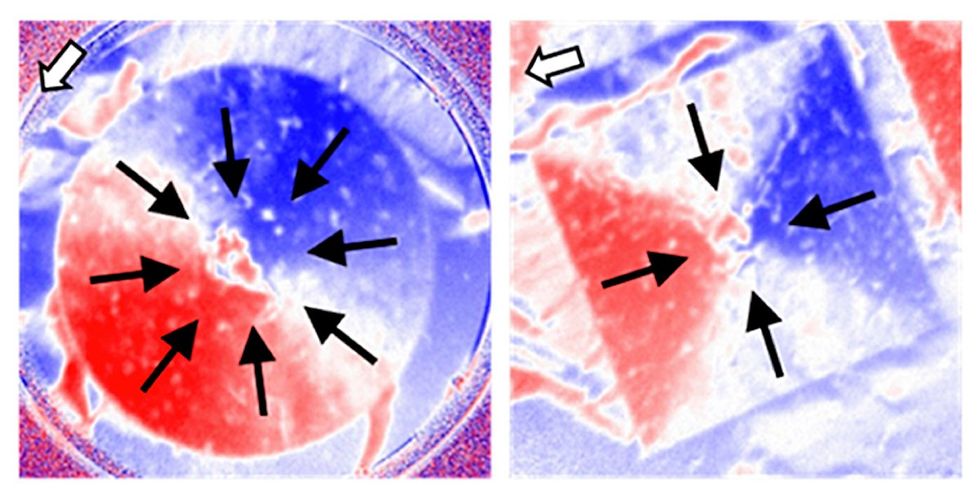Ferromagnetism and superconductivity don’t play well together. Ordinarily the two phenomena—ferromagnetism grants garden-variety permanent magnets their magnetic fields and superconductivity expels the internal magnetic fields of certain materials cooled below critical temperatures—seem to cancel each other out.
But under uncommon circumstances, the two phenomena can behave with one another. One such circumstance could be a promising boon for future spintronic devices that operate more quickly and use less energy than their electronic counterparts.
Researchers have now etched magnetic patterns into micrometer-size “islands” of a superconductor topped with a ferromagnetic material. These kinds of magnetic textures usually are not very stable, but these islands retain them well above the superconductor’s critical temperature. The researchers hope that, one day, an “archipelago” of magnet-twisted isles might serve as a spintronic device’s memory.
The superconductor in question is yttrium barium copper oxide (YBCO), which acts as a superconductor below –181 °C—far from room temperature but positively balmy by the standards of most superconductors. When YBCO is chilled below that critical temperature, any magnetic field lines that pass through its interiorget expelled to its exterior. However, researchers can still cast magnetic field lines throughthe YBCO’s interior byblasting it with a new external magnetic field, then quickly turning off that magnetic field.

Researchers found that if they layer a nonsuperconducting ferromagnetic material atop the YBCO, they can imprint those temporary magnetic patterns through the superconductor and “write” them into the ferromagnet. Then the ferromagnet will hold this pattern even after the external magnetic field is switched off. This is an ability of great interest for spintronics, the discipline already investigating how to use these kinds of magnetic structures as computer memory instead of the CMOS transistors that underpin most of today’s electronics.
Spintronics could make far better use of this ability if it could work at room temperature. Under normal circumstances, this should not happen. If the YBCO base warms above −181 °C, the writing in the ferromagnet above it should vanish. But in prior experiments, researchers found that the ferromagnet retained traces of the patterns well above that critical temperature. “We observe that the imprinted pattern did not completely disappear,” says Sergio Valencia, a physicist at the Helmholtz Center for Materials and Energy and who was involved in the research. “There was a retention of the imprinted state, some memory.”
Valencia and his colleagues were able to identify this retention’s cause: Tiny specks of cuprous oxide that sprouted atop the YBCO and became sandwiched under the ferromagnetic material. These defects, in fact, helped stabilize part of the magnetic field in the ferromagnet.
“This is one of the keys to turn this hybrid superconducting/magnetic system into a fully functional spintronic system.” —Javier Villegas, Paris-Saclay University
This knowledge enabled the researchers to craft groups of superconducting “islands,” each island about 2 micrometers in diameter and mounted with a ferromagnetic material (a mixture of 80 percent nickel and 20 percent iron). The researchers used magnetic fields to etch each island’s ferromagnet with a vortex-shaped magnetic pattern. These kinds of magnetic vortices have interested spintronics researchers for years. The researchers created two kinds of vortices: one that fit within a square hole, the other into a circular hole.
Actually studying these islands in action required imaging them by exciting their electrons with the high-powered X-rays of a synchrotron. The researchers studied how each kind of vortex held up as they were heated to near–room temperature. Although far from perfect, circular vortices held up better than square ones.
That either type held up at all is a potentially promising achievement. Today, it is difficult to write and rewrite magnetic patterns like these—in other words, to manipulate the spins of their underlying electrons—but engineers will need to figure out how to do that if they want to harness those patterns for a spintronic device’s memory. The researchers hope that their work might become a template for exploring yet-undiscovered sorts of islands or other structures that make the task easier.
“We hope that our research, showing a method to obtain these magnetic structures in a variety of compounds, might help to optimize these functional spintronic systems by allowing a much broader range of materials, with different properties, to be investigated,” Valencia says.
“The underlying idea here is to see whether superconducting may allow ‘imprinting’ spin textures in a specific, more efficient, or useful way. Our work illustrates that this is the case,” says Javier Villegas, a physicist at the Paris-Saclay University, in France, and another of the researchers in this group.
The researchers next want to improve the islands, shrinking them down to less than a micrometer in size and making them better at retaining their writings. Additionally (and crucially) the group wants to create a way to probe the islands’ writings with electric current. This would allow the researchers to read the magnetic memory without having to cart everything to a synchrotron.
“This is one of the keys to turn this hybrid superconducting/magnetic system into a fully functional spintronic system,” Villegas says.
The group published their work on 2 April in the journal ACS Applied Materials & Interfaces.


